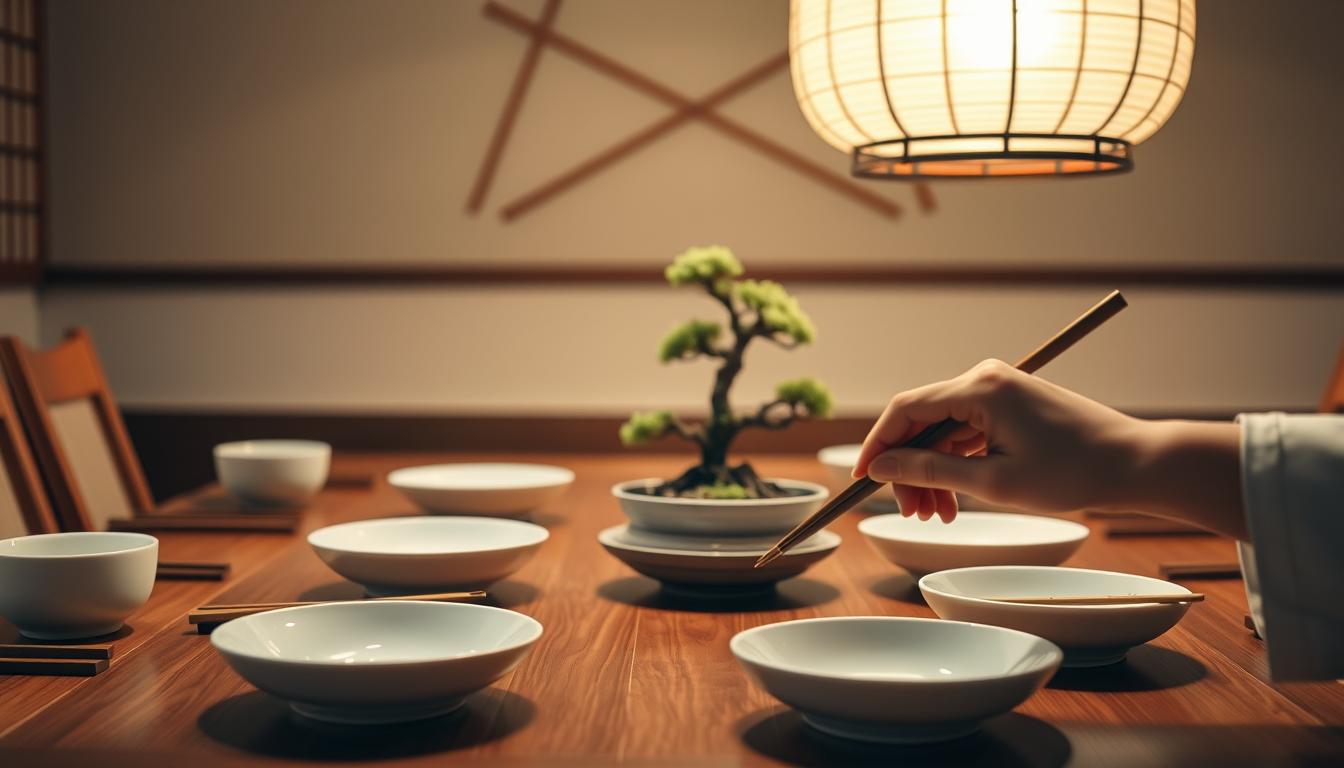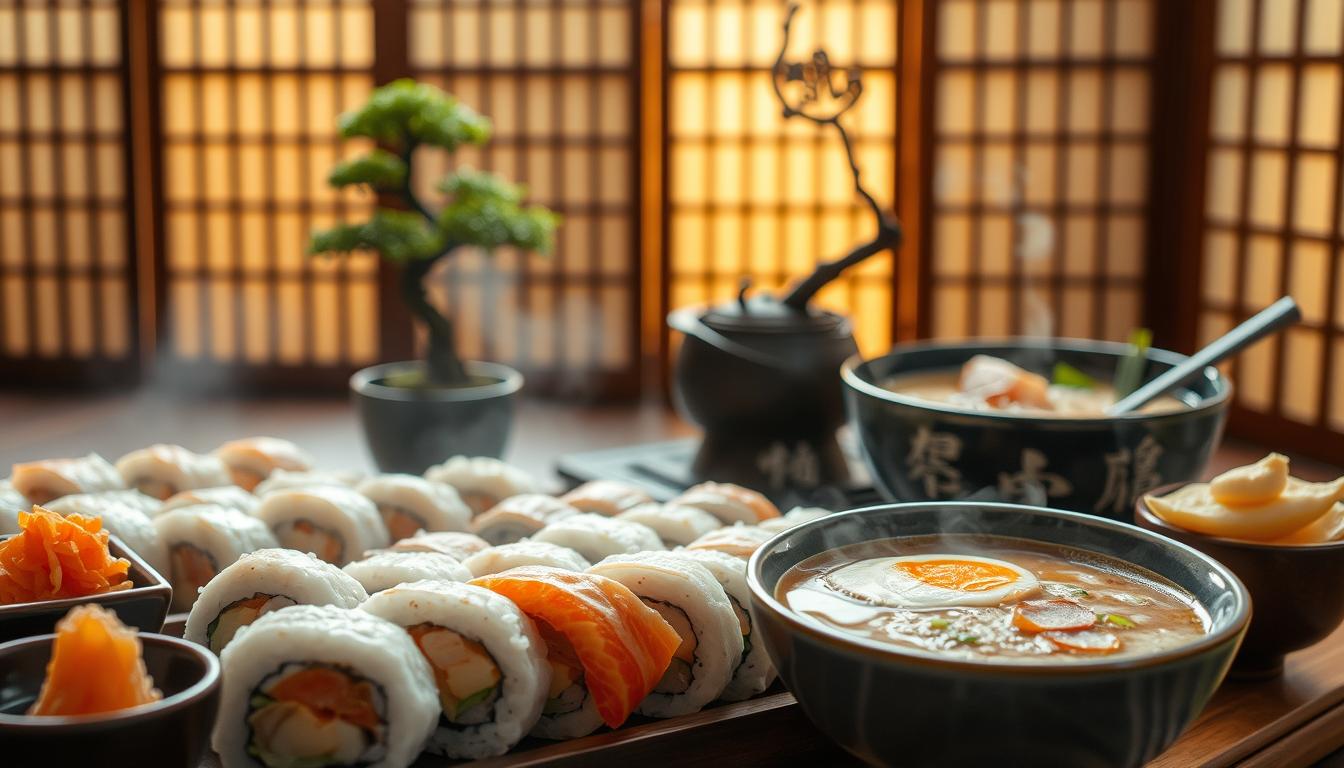Japanese cuisine is renowned for its emphasis on fresh ingredients, seasonality, and simple preparation methods. With a history spanning centuries, it has evolved into a unique blend of traditional and modern elements. This rich culinary heritage is not just about the food; it’s an experience that encompasses the culture, history, and aesthetics of Japan.
Key Takeaways
- The evolution of Japanese cuisine is deeply rooted in its history and geography.
- Traditional Japanese cuisine emphasizes the use of fresh, seasonal ingredients.
- The presentation and aesthetics of the dishes play a significant role in the overall dining experience.
The Evolution of Japanese Cuisine
The evolution of Japanese cuisine is a story of cultural and culinary transformation. Historically, Japanese cuisine has been influenced by various factors including geography, climate, and cultural exchange.
Essential ingredients have played a crucial role in shaping Japanese cuisine. Rice, being a staple, has been central to most meals. The introduction of Buddhism and the subsequent prohibition on meat consumption led to a focus on seafood and plant-based ingredients.
Over time, Japanese cuisine has incorporated elements from other cultures, notably Chinese and Korean, resulting in a unique fusion. This is evident in dishes like Tempura, which was introduced by the Portuguese.
The emphasis on seasonality and freshness has also defined Japanese cuisine. The use of seasonal ingredients ensures that dishes are vibrant and flavorful. This approach, combined with simple yet sophisticated preparation methods, has contributed to the global popularity of Japanese cuisine.
Essential Ingredients in Japanese Cuisine
Japanese cuisine is renowned for its emphasis on fresh ingredients, seasonality, and simple preparation methods. At the heart of this cuisine are rice, fish, and soy products, which play crucial roles in defining its character.
Rice: The Foundation
Rice is a staple in Japanese cuisine, serving not just as a side dish but as an integral component of meals. Short-grain rice is preferred for its sticky texture, which makes it easier to handle with chopsticks.
Fish: Freshness Matters
Fish is a vital ingredient, with freshness being paramount. The variety of fish used in Japanese cuisine is vast, ranging from salmon and tuna to mackerel and sardines. Fish is often served raw as sashimi or cooked in various dishes.
Soy Products: Versatility and Nutrition
Soy products, including tofu and miso, are staples. Tofu is versatile and can be prepared in numerous ways, while miso is used to make a variety of soups and sauces. These products are rich in protein and are integral to Japanese cuisine.
Iconic Japanese dishes often feature these ingredients prominently. The combination of rice, fish, and soy products creates a culinary experience that is both simple and sophisticated.
Iconic Japanese Dishes
From sushi to ramen, Japanese cuisine has a plethora of iconic dishes that are loved globally. These dishes not only tantalize the taste buds but also reflect the rich cultural heritage of Japan.
Sushi and Sashimi
Sushi and sashimi are among the most recognizable Japanese dishes worldwide. Sushi is a dish that combines vinegared rice with various ingredients such as raw fish, vegetables, and seafood, often wrapped in seaweed. Sashimi, on the other hand, is thinly sliced raw fish served without rice. Both dishes are prepared with great care and attention to detail, reflecting the importance of freshness and seasonality in Japanese cuisine.

- Sushi comes in various forms, including maki rolls, nigiri, and temaki.
- Sashimi is often served with soy sauce, wasabi, and pickled ginger.
- Both sushi and sashimi are integral to Japanese dining etiquette, emphasizing respect for the food and the chef.
Ramen and Udon
Ramen and udon are popular Japanese noodle soups that have gained international acclaim. Ramen is a rich, flavorful broth served with wheat noodles and various toppings such as pork, boiled eggs, and green onions. Udon is a thicker, wheat flour noodle often served in a hot broth or with dipping sauce. Both dishes are comforting and flavorful, showcasing the diversity of Japanese noodle soups.
- Ramen has regional variations, with different broths and toppings.
- Udon is known for its thick, chewy texture and is often enjoyed in a hot broth.
- Both ramen and udon are enjoyed in casual and formal settings, highlighting their versatility in Japanese dining culture.
Understanding and appreciating these iconic dishes is also about respecting Japanese Dining Etiquette. For instance, it’s customary to wait for the host to start eating before you begin, and to try a bit of everything served. These customs enhance the dining experience, making it more enjoyable and respectful.
Dining Etiquette in Japan
Japan is known for its rich cultural heritage, and dining etiquette is an essential part of it.
Regional Variations
Different regions in Japan have their own unique customs and practices when it comes to dining etiquette.
- Wait for the host to indicate where to sit.
- Use chopsticks correctly.
- Try a little of each dish.

Regional Variations in Japanese Cuisine
Japanese cuisine is a rich and diverse reflection of the country’s history and culture. From its emphasis on fresh ingredients to its varied regional specialties, Japanese cuisine offers a unique culinary experience that is worth exploring.
## FAQ
### Q: What is the significance of rice in Japanese cuisine?
Japanese cuisine places a strong emphasis on rice, which is a staple food in Japan. It’s often served with most meals and is a key component of Japanese cuisine.
### Q: What are the essential ingredients in Japanese cooking?
The essential ingredients in Japanese cooking include soy sauce, wasabi, and pickled ginger, which are used to add flavor and depth to various dishes.
### Q: What is the difference between sushi and sashimi?
Sushi refers to vinegared rice topped with raw or cooked seafood, while sashimi is raw seafood sliced into thin pieces and served without rice.
### Q: What is the cultural significance of dining in Japan?
Dining in Japan is not just about eating; it’s a cultural experience that involves respect for tradition, hospitality, and community. Mealtimes are often seen as opportunities to bond with others and build relationships.
### Q: What are some common ingredients used in Japanese cuisine?
Some common ingredients used in Japanese cuisine include rice, noodles, seafood, soy sauce, and wasabi. These ingredients are often combined in various ways to create a wide range of dishes.
### Q: What is the history of Japanese cuisine?
Japanese cuisine has a rich history that spans centuries, with influences from China, Korea, and other cultures. It has evolved over time, incorporating new ingredients and cooking techniques while maintaining its traditional roots.



